In the United States, private wells are the primary water source for over 15 million households. However, private wells don’t face the same safety requirements as public water sources.
If you have a private well, you have to make sure your water is safe to drink. A home water well testing kit is the perfect tool for this.
After evaluating numerous testing kits, we determined the best well water testing kit to be the MyTapScore water testing kit which offers detailed reports and treatment recommendations.
Keep reading to learn about the best well water testing kits and how to choose the right one.
Best Well Water Testing Kits
1. My Tap Score Well Water Water Test Kit
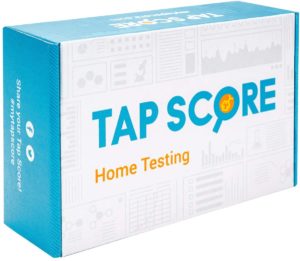
The My Tap Score Water Test lets you check your spring or water well quality from home. Take the sample and then send it to the laboratory for a detailed report and unbiased treatment recommendation.
A significant benefit of this product is the level of detail you can request in terms of results. Choose from essential, advanced, or extended tests.
The essential well water test includes readings for general chemistry, heavy metals, dangerous bacteria like e.coli, nitrate, nitrite, silica, hardness, and alkalinity.
The advanced kit further provides readings for industrial chemicals, disinfection byproducts, and oil and gas.
Finally, the extended kit tacks on readings of tannins, radioactive particles, pesticides, plasticizers, and flame retardants.
Further, you can select from simple informational testing options or get certified test results. You can even choose from certification levels if you need to submit results to your state for compliance reasons. Their laboratory tests also offer business solutions for bulk orders.
The product comes with a 100% satisfaction guarantee, and shipping is covered both ways. You also have the option to purchase “add-ons” and check for unique things like iron-related bacteria or slime-forming bacteria.
Although this isn’t the cheapest water test kit on the market, it offers high-quality results. SimpleLab, the company behind the product, has been awarded EPA research grants and been cited in leading industry publications. This is a reputable and respected provider of water tests.
Finally, the testing is fully independent. While the company can recommend treatment products, they don’t sell those products themselves. This eliminates concerns regarding conflict of interest.
- Easy DIY test process.
- Diverse test options for different levels of report detail.
- Get a customized water report card to help you understand your health risks and match treatment to contaminants.
- More expensive than other options on the market.
- Lab testing may take time.
2. Watercheck Test Kits
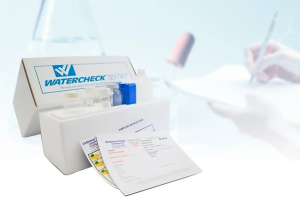
The Watercheck Water Test Kits lets you take a water sample and send it off for testing. You don’t have to worry about analyzing your results, but you will have to wait for the lab to contact you with your well water status.
This home well water test kit can detect up to 75 contaminants, including heavy metals, bacteria, volatile organic chemicals (VOCs), and physical problems. You can also opt for an additional test to check for pesticides and herbicides.
It will also detect both a presence and a lack of bacteria, so you will know what condition your well is in.
Once you send the test, it will take a couple of weeks to come back. You will send your kit to National Testing Laboratories, LTD, and they will run the test for you.
The test kit includes vials that you can fill with water from your well, and you have everything you need to collect the samples. However, you will have to pay for shipping to get the water to the lab.
You may also want to run some tests before this one to check for oils and hydrogen sulfide. Those compounds can make the Watercheck test less effective, but you can use a pre-treatment to get rid of those things.
SpringWell does provide a warranty against defective tests, but it won’t cover accidents or improper use. So once you get the kit, make sure you take care of the supplies to conduct a proper water test.
- Tests for almost anything you could think of
- Optional test for pesticides
- Tests are run by an industry-recognized lab
- Easy to run the test
- Get your results relatively quickly
- Expensive for a single test
- Shipping to the lab costs extra
3. Safe Home ULTIMATE Drinking Water Test Kit
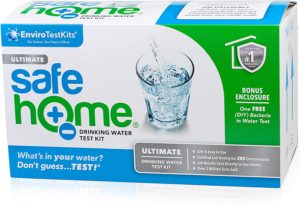
Another option for the best home well water test kit is the Safe Home ULTIMATE Drinking Water Test Kit. It can detect 200 different things that may be in your well water supply. The test can recognize heavy metals, VOCs, inorganic compounds, and pesticides.
You can also use it to test for total coliform bacteria, which includes E. coli. The bacteria test is DIY so that you can get your results immediately. But you will need to send the rest of the test to a lab to check for the other contaminants.
The lab will send you your results via email within a couple of weeks. And if it takes longer, you can get your next test for free. The cost of the test kit includes all lab fees, and you can send your water sample for free as well.
This test has the Good Housekeeping Seal, and various labs have vetted the test. The company also follows safe practices when running the test, and that doesn’t affect their ability to run the test on your water.
As a confirmation test, this kit will take more time than pre-screening tests. However, it provides a comprehensive list of pathogens that are in your well water.
You can collect the water samples directly from your kitchen sink or the well, and you can put them in the vials that come with the kit. And since shipping is free, you won’t have to pay extra to send your kit to the lab.
When you get the test results, you’ll know what you need to do to filter your water. The results are significant for informational use, but they’re not suitable for regular reporting.
- Tests for hundreds of potential contaminants
- Shipping to the lab is free
- Results come back in a couple of weeks
- Safe testing practices help with the results
- Includes at-home bacteria test
- More expensive than the competition
- Not for governmental reporting
4. Watersafe Drinking Water Test Kit
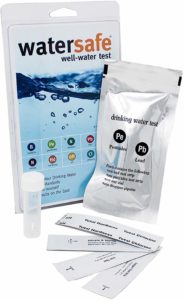
If you’re looking for a home well water test kit that doesn’t require a lab, consider the Watersafe Drinking Water Test Kit. You get all of the tools and supplies to run the test, and it’s easy to use and makes a great science project.
The kit can test for lead, bacteria, chlorine, and pesticides. This test follows EPA standards and has been validated in an official lab. All you need to do is add water to the test strips in the kit, and you can get your results.
You can use the instruction manual to read your results, and you get labels that you can use to test for copper, iron, and other minerals. It doesn’t matter if you studied science a lot so that anyone can conduct this test.
Unlike other well water testing kits, you don’t need to contact a lab to run the samples. You won’t have to deal with shipping so that you can get your results much faster.
The results include a few different levels based on how safe the water is for certain contaminants. Levels include safe to drink, safe to shower in or wash hands, and safe on washing clothes.
If you don’t get the safest results, you can determine what the problem is. Then, you can tackle the issue with the right water filter.
This test kit is only for single-use, but it’s much more affordable than lab tests. You can get a few kits to have on hand for whenever you want to test the water. If you find the water tastes or smells odd, you can run a test to see.
- Easy to run
- Uses different levels of safety
- Doesn’t require a lab or shipping time
- Affordable for home well use
- Tests dozens of common contaminants
- Some kits have missing parts
- Results aren’t always accurate
5. JNW Direct Drinking Water Test Strips
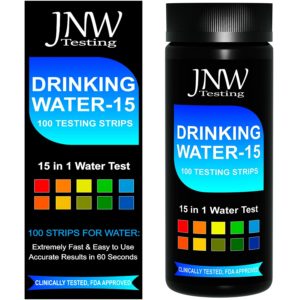
The JNW Direct Drinking Water Test Strips are also great if you want to test your well water yourself. You can use the test to detect ten common contaminants, including iron, copper, and lead. It can also tell you how hard your water is and the water’s pH level.
This test kit includes 125 test strips, and you can use one test at a time. So even if you test your water weekly, this will last for over two years. Once you open the strip, you’ll have 90 days to use it before it expires.
You can use the test kit yourself or with your kids, and it can be a fantastic home project. If you want to confirm your results, you can also do multiple tests at once.
The home well water test kit comes with everything you need to run the test. You can put the test strip in a glass of water, and you’ll get your results within a minute. It gives accurate results if you test water directly from your well or your kitchen sink.
You’ll get an eBook covering EPA water standards, and the book gives tips on how to improve your water. The strips also have a compatible smartphone app that you can use to track your test results.
This test kit comes with a waterproof color chart, and the colors are easy to read. That way, you don’t have to worry about guessing when reading your results. Each parameter in the test appears as a different color on the test strip to minimize confusion.
If you’re new to using well water, this kit is a great option. It’s affordable and comes with more than enough tests. While it’s not as extensive as some well water testing kits, it can detect many common things in your water.
- Accurate and fast results
- Enough tests to last for a couple of years
- Convenient mobile app to track results
- Color chart to help read tests
- Easy to use
- Doesn’t test for many things
- Small change in color from safe to unsafe levels
Choosing the Right Test Kit for Your Well
When deciding between well water testing kits, you should consider what you need to test. You may also want to determine how often you’ll test your water. Those and other factors can help you decide which kit to use.
Local Contaminants:
Depending on where you live, you may have different contaminants flowing through your well water. Most contaminants fall under a few categories, including physical, chemical, and biological. If you don’t know what to look for, you may want a more exhaustive water test kit.
On the other hand, if you’ve used tests before and have had problems with a few things, you can look for a more specific test.
No two cities will have the same levels of the same pathogens. So consider where you live and what’s most common in the local water supply. Think about the nearby rivers and creeks and other water sources.
Then, you can make sure your home well water test kit covers everything you need to check.
Testing Frequency:
You should also think about how often you plan to test your well water. In some cases, you may only need to test your water once per year. But you may also want to do a test whenever your water changes color or taste.
If you know you’ll want to test your water more frequently, consider ordering tests in bulk. You can also look for well water testing kits with multiple tests.
But if you just need to test the water to follow CDC guidelines, you can get away with yearly testing. In that case, you can get a singular test once per year, and you won’t need to keep tests on hand.
Lab or Home:
If you want to ensure that your well water is safe to drink, you should consider sending your well water testing kits to a lab. While at-home tests can be convenient and affordable, they aren’t always the best option.
Some at-home kits don’t check for as many pathogens as tests you send to a lab. It’s also up to you to read and interpret your results, which can be difficult. If you don’t understand something quite right, the mistake might harm you or your family.
Sending well water testing kits to a lab won’t guarantee perfect, accurate results. But the scientists working in the lab will be better able to read the test.
Lab scientists have read dozens, if not hundreds, of water tests so that they can distinguish between safe and unsafe levels. If a contaminant level is just about the threshold for what’s safe, it can be hard to see that on a test at home.
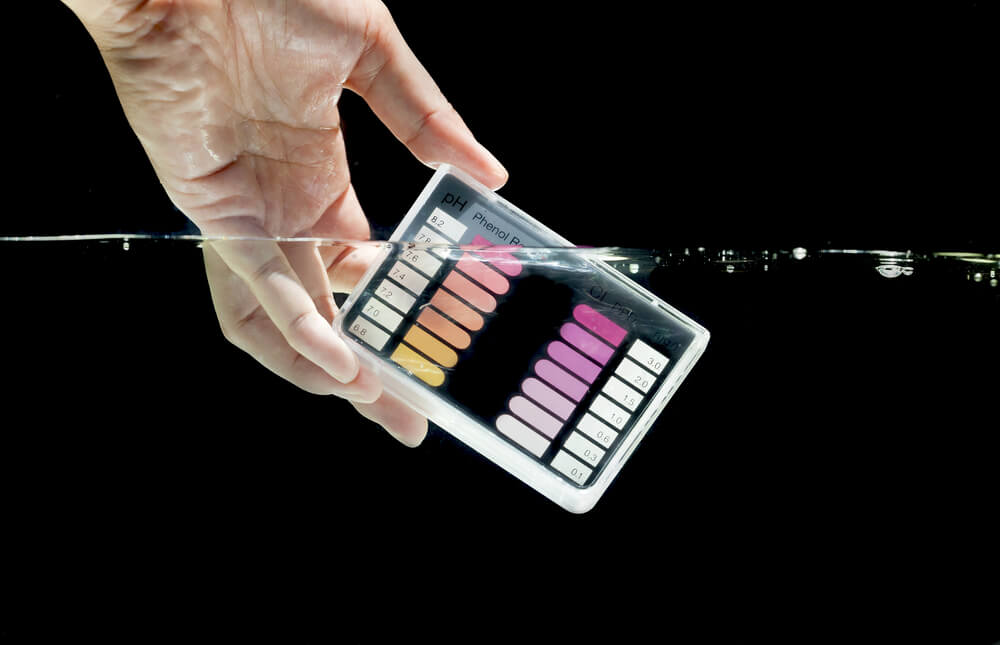
Well Size:
When deciding how to test your well water, you should also consider how big your well is. A shallower well typically contains water that hit the ground in the last couple of years. However, deeper wells can hold water from as long as a decade ago.
This is important because it can affect what you test for and how often you should test. If your well is relatively shallow, you may want to test your water more often because it can change more.
And if you need to test your water more frequently, you should choose an affordable test. That way, it won’t be as expensive to keep an eye on your water supply.
How to Test Your Well Water
Once you get your home well water test kit of choice, it’s time to collect a sample. Whether you go with an at-home test, or send your water to a lab, follow these steps to get the most accurate results possible.
Review the Directions:
The first thing to do when you get a home well water test kit is to review the directions. Consider how you will collect the water, such as in a tube or a larger glass. If you run the test, you should read through how to do that and read your results.
And if you’re sending the test to a lab, you just need to read through what you have to do. Then, make sure you have the packing and shipping covered. And in both cases, you should know what contaminants the test will detect to avoid surprises.
Get a Water Sample:
Next, it’s time to get a water sample, and you can use your well or your kitchen sink. As long as you don’t currently have a water filter, the tap should be close to what’s in the well.
You can use a cup to collect the water, and then you can separate the water into vials or other containers for the test. Lab tests typically use vials, but some use special strips that you put into water. Get a decent amount of water so that you have enough to collect or run the test.
Run the Test:
If you choose an at-home test kit, it’s time to run the test. Some of the best home well water testing kits use strips to change colors to give you the results.
In that case, you’ll need a glass or bowl big enough to fit the entire strip. That way, you can make sure the results show up throughout.
You should set out a paper towel to have a place for the test to sit after you put it in water. Within a few minutes, the test should show you the various contaminants in your water.
Send to a Lab:
If you decide you want a lab well water test kit, you need to ship it to the lab. Make sure the vials and containers are secure so that your water won’t leak out.
Some of these tests include free shipping for your test to get to the lab. However, you may need to pay for express shipping so that it gets to the lab overnight.
The quicker your test gets in, the sooner the lab can run it, and then you’ll get your results sooner. But you may need to be patient if the lab has a lot of tests to run.
Review the Results:
When you get your results, either after the test strips change colors or after the lab contacts you, you can review the test. Different tests may have unique systems for showing results so that you can consult an instruction manual for help.
If you’re reviewing the results from an at-home test, you can compare colors and other factors with what’s normal. Your kit should include a tool to make this comparison.
For lab tests, you should get a list of the contaminants they tested and your results. If the results don’t tell you if the amount is safe, you can consult the EPA for specifics.
If your water is clean, you can rest easy knowing that, and you can wait until next year for another test. But if your water has some contamination, you can use that information to find a water filter to make sure only clean water makes its way through your house.
Conclusion
If you want the best home well water test kit, consider the SafeHome ULTIMATE Drinking Water Test Kit. It can test for tons of contaminants, and the lab will help you read your results. Plus, shipping to the lab is free.
A more affordable option would be the Watersafe Drinking Water Test. You can run the test at home, but it still checks for a lot more contaminants than other well water testing kits.

